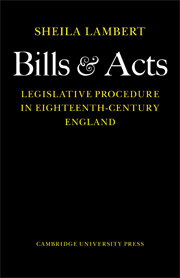Book contents
- Frontmatter
- Contents
- Preface
- Abbreviations
- Introduction
- 1 Robert Harper and parliamentary agency
- 2 Treatises and handbooks
- 3 The clerks: fees and agency
- 4 Parliamentary business
- 5 Private bill procedure
- 6 Estate bills
- 7 Inclosure bills
- 8 Local bills
- 9 Promulgation of the statutes
- 10 Conclusion
- Appendix I List of bills drawn by Robert Harper
- Appendix II Note on parliamentary sources
- Index
5 - Private bill procedure
Published online by Cambridge University Press: 07 October 2011
- Frontmatter
- Contents
- Preface
- Abbreviations
- Introduction
- 1 Robert Harper and parliamentary agency
- 2 Treatises and handbooks
- 3 The clerks: fees and agency
- 4 Parliamentary business
- 5 Private bill procedure
- 6 Estate bills
- 7 Inclosure bills
- 8 Local bills
- 9 Promulgation of the statutes
- 10 Conclusion
- Appendix I List of bills drawn by Robert Harper
- Appendix II Note on parliamentary sources
- Index
Summary
The private bill procedure was used not only for those bills that subsequently became private acts, but also for all bills affecting private or local interests. Before 1720, some road and harbour bills, having gone through the private bill procedure, were classified by the King's Printer as private acts, but after that date, although they followed the same procedure in parliament, they were classified and printed as public acts at the end of it.
All these bills of course paid fees, but fees were also payable by parties taking benefit from any act whatever, and it was in this area that disputes arose as to whether fees should be charged. As the order of 1751 clearly states, ‘every bill for the particular interest or benefit of any person or persons, whether the same be brought in upon petition, or motion, or report from a Committee, or brought from the Lords, hath been and ought to be, deemed a private bill, within the meaning of the Table of Fees.’ It is not possible to have a more comprehensive definition than this. The list printed by Hatsell, is not a list of private bills, but a list of bills on which fees had been paid, which is not at all the same thing. Similarly, the sections of the Liverpool Tractate dealing with private bill procedure refer not at all to private acts as such, except for one very slight reference to inclosure, but to those public acts which were required to pay fees and to go through the private bill procedure.
- Type
- Chapter
- Information
- Bills and ActsLegislative procedure in Eighteenth-Century England, pp. 84 - 109Publisher: Cambridge University PressPrint publication year: 1971



